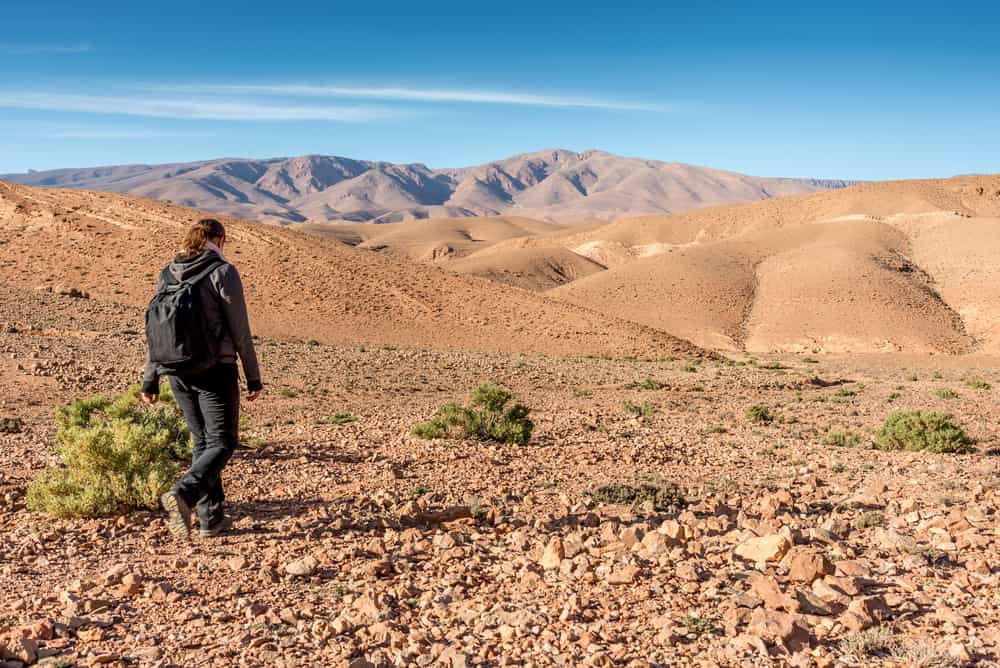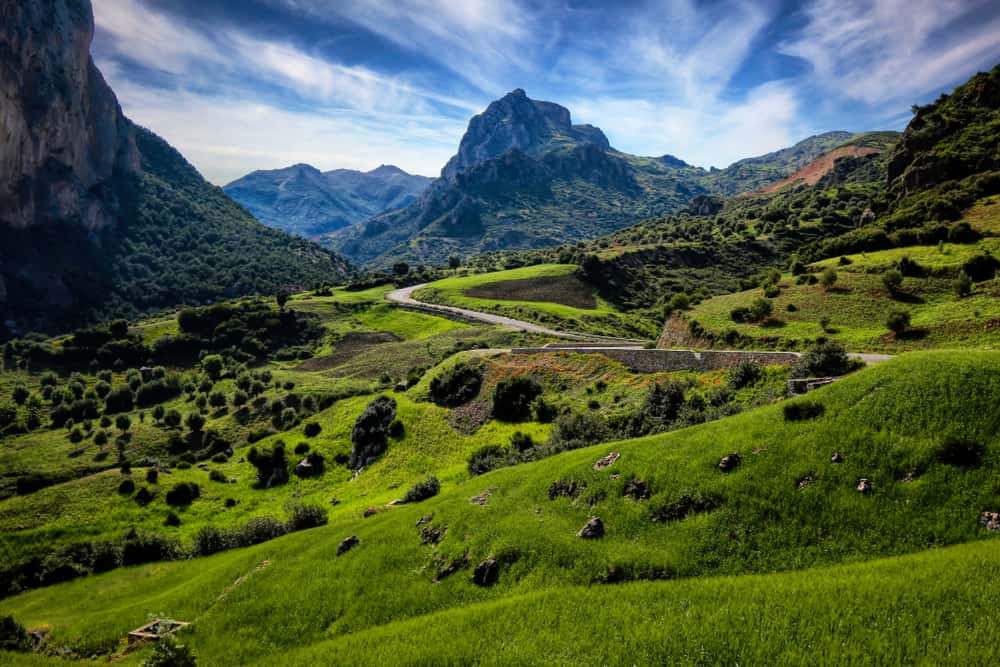Morocco’s one of its most breathtaking features is its majestic mountains. The Atlas and Rif Mountains provide thrilling escapes into nature, filled with stunning vistas and rich cultural experiences. The Atlas Mountains are renowned for their towering peaks and diverse terrain, including Mount Toubkal, the highest peak in North Africa. Trekkers here can enjoy challenging trails and immerse themselves in the vibrant Berber culture.
In contrast, the Rif Mountains in northern Morocco are lush and green, offering a different trekking experience. This less-traveled region features verdant valleys, forested trails, and the charming Blue City of Chefchaouen. The Rif Mountains provide a serene and peaceful trekking environment, perfect for exploring Morocco’s natural beauty away from the more frequented paths.
This guide will explore the key features and popular hiking trails of both the Atlas and Rif Mountains. It will also provide essential tips for mountain trekking in Morocco, ensuring you are well-prepared for an unforgettable adventure. Whether you are a seasoned trekker or a beginner, Morocco’s mountains promise an extraordinary journey through some of the world’s most beautiful and culturally rich landscapes.
Exploring the Atlas Mountains
The Atlas Mountains are one of Morocco’s most stunning natural features. Stretching over 2,500 kilometers, they offer diverse landscapes and rich cultural experiences. From the highest peaks to the green valleys, the Atlas Mountains are a trekker’s paradise. Let’s explore the key features that make the Atlas Mountains so special, explore some popular hiking trails, and discover the cultural highlights along these routes.

Key Features of the Atlas Mountains
The Atlas Mountains are a grand range that spans across Morocco. These mountains are tall and mighty, with some peaks covered in snow. The highest peak is Mount Toubkal, which is the tallest mountain in North Africa. The Atlas Mountains have a variety of landscapes, including lush valleys, rocky cliffs, and high plateaus. This area is also home to many different plants and animals. You might see monkeys, eagles, and colorful flowers as you trek.
The Berber people have lived in the Atlas Mountains for thousands of years. They have their language and traditions. When you trek through the Atlas, you can visit Berber villages and learn about their way of life. You might even stay in a Berber home and enjoy traditional food.
Popular Hiking Trails in the Atlas Mountains
One of the most popular trails in the Atlas Mountains is the trek to Mount Toubkal. This hike is challenging but rewarding. It usually takes two days to reach the summit. From the top, you can see the stunning view of the surrounding mountains and valleys. Another great trail is the Azzaden Valley trek. This hike takes you through green valleys, past waterfalls, and into remote Berber villages. It is a great way to see the natural beauty and culture of the Atlas Mountains.
The Ourika Valley trek is another fantastic option. It is less challenging and perfect for beginners. This hike follows a river and passes through several small villages. You will see terraced fields, orchards, and traditional stone houses. It is a peaceful and scenic walk.
Cultural Highlights Along the Trekking Routes
Trekking in the Atlas Mountains is not just about the scenery. It is also a chance to experience Berber culture. The Berbers are known for their hospitality. You might be invited to share a meal or stay overnight in a Berber home. Traditional Berber food includes dishes like tagine, which is a slow-cooked stew, and couscous, a type of grain served with vegetables and meat.
In addition to food, you can learn about Berber crafts. The Berbers make beautiful rugs, pottery, and jewelry. You might see women weaving rugs or men making pottery as you pass through the villages. These crafts are often made using techniques passed down through generations.
Discovering the Rif Mountains
The Rif Mountains in northern Morocco are a hidden gem. While not as well-known as the Atlas Mountains, the Rif offers lush greenery, unique trails, and a serene trekking experience. These mountains are perfect for those looking for peaceful hikes and beautiful scenery. We will explore the characteristics of the Rif Mountains, highlight notable hiking trails, and share some unique experiences you can find in this region.

Characteristics of the Rif Mountains
The Rif Mountains are located in northern Morocco. They are not as tall as the Atlas Mountains, but they are very green and lush. The Rif is known for its forests, rivers, and valleys. This region has a mild climate, which makes it a great place for hiking all year round.
The Rif Mountains are home to many different plants and animals. You might see olive trees, wildflowers, and even monkeys as you hike. The area is also known for its rich biodiversity. The people living in the Rif are friendly and welcoming. They often live in small, picturesque villages.
Notable Hiking Trails in the Rif Mountains
One of the best trails in the Rif Mountains is the hike through Talassemtane National Park. This park is full of beautiful scenery, including forests, rivers, and waterfalls. The trails are well-marked and suitable for all levels of hikers. Another great trail is the hike from Chefchaouen to Akchour. This path takes you through stunning gorges and leads to the famous God’s Bridge, a natural stone arch over a river.
Another popular trail is the hike to Jebel Kelti, a mountain with fantastic views of the surrounding area. This hike is more challenging, but the views from the top are worth the effort. You can see the Mediterranean Sea and the rolling hills of the Rif Mountains.
Experiences Unique to the Rif Region
The Rif Mountains offer many unique experiences. One of the highlights is visiting the Blue City of Chefchaouen. This town is famous for its blue-painted buildings and narrow, winding streets. It is a great place to explore, shop for souvenirs, and take photos. Chefchaouen is also known for its relaxed atmosphere and friendly locals.
Another unique experience in the Rif Mountains is visiting local markets. These markets are full of fresh produce, spices, and handmade crafts. You can try local foods like olives, honey, and traditional bread. The markets are a great place to meet local people and learn about their way of life.
Essential Tips for Mountain Trekking in Morocco
Trekking in Morocco’s mountains is an adventure of a lifetime, but preparation is key to a safe and enjoyable experience. Whether you are planning to trek in the Atlas or Rif Mountains, there are essential tips you need to know. From what to pack to safety precautions and environmental considerations, this section will provide you with all the necessary information to ensure your trekking adventure is both safe and memorable.
Preparation and Planning
Before you start your trek in Morocco, it is important to plan and prepare. The best time to go trekking in Morocco is in the spring or fall. The weather is mild, and the trails are not too crowded. Make sure to pack the right gear. You will need sturdy hiking boots, a warm jacket, a hat, and sunscreen. It is also important to bring plenty of water and snacks.
It is a good idea to hire a local guide. They know the trails well and can help you navigate. They can also share interesting information about the area and its culture. Guides can help you communicate with locals if you do not speak the language.
Safety Precautions
Safety is very important when trekking. Always stay on marked trails and avoid hiking alone. Let someone know your plans and when you expect to return. Be aware of the weather and be prepared for changes. It can get very cold at high altitudes, even in the summer.
Watch out for wildlife and respect their space. Do not feed or approach animals. Make sure to leave no trace. Carry all your trash with you and do not disturb plants or wildlife. Respect the local culture and traditions. Dress modestly and be polite to locals.
Environmental Considerations
When trekking, it is important to protect the environment. Stay on designated trails to avoid damaging plants. Do not pick flowers or disturb wildlife. Carry a reusable water bottle and avoid using plastic bags. Support local conservation efforts by following guidelines and respecting the natural surroundings.
Be mindful of your impact on the local communities. Buy local products and use local services. This helps support the local economy and encourages sustainable tourism. Be respectful of local customs and traditions. This helps create a positive experience for both visitors and locals.
Conclusion
Trekking in Morocco’s mountains offers an unforgettable adventure. The Atlas Mountains provide majestic views and rich cultural experiences. The Rif Mountains offer lush landscapes and unique experiences. By preparing well and respecting the environment and local culture, you can have a safe and enjoyable trek.
